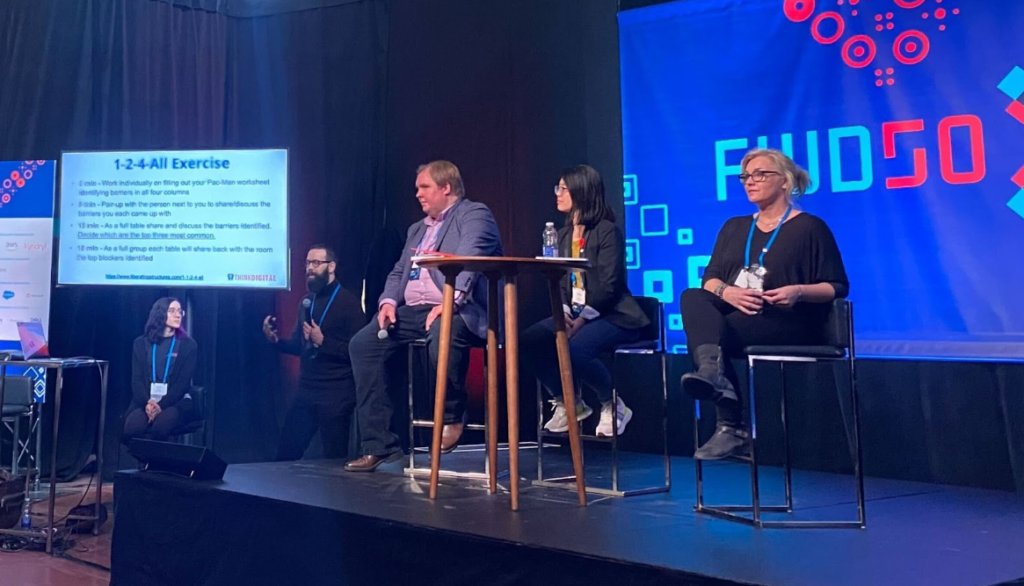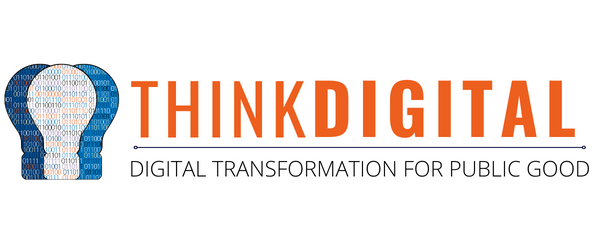Insights from Think Digital’s “Pac-Man” workshop at FWD50 2022
December 12, 2022
By Luke Simcoe, Associate, Think Digital (along with contributions from the Think Digital team)
Here at Think Digital, we tend to agree with the idea that “culture eats strategy for breakfast.” No digital or innovation strategy will succeed if organizational culture isn’t aligned with its aims and methods.
But we know culture doesn’t tell the whole story. Culture is elusive; it’s emergent. You can’t really change culture, at least not directly. But you can change the things that determine and produce culture, like how people are rewarded (incentives) and the way decisions get made (structures).
This is the logic behind our “Pac-Man” model of digital transformation. It suggests that if culture eats strategy, then incentives eat culture, and structures eat everything else.

We brought the Pac-Man model to FWD50 this year, as a way of kickstarting a conversation about how structures and incentives in government act as blockers to the culture required to deliver 21st century public services.

Our Think Digital team at the FWD50 Workshop (from left to right: Aislinn Bornais, Research Assistant; Luke Simcoe, Associate; Ryan Androsoff, CEO & Founder; Dorothy Eng, Associate; Winter Fedyk, Associate).
It was our first time delivering the workshop and we weren’t sure what to expect. Would FWD50 attendees be as keen as us to look at their work through the lens of incentives and structures?
Fortunately, the answer was yes. The room was packed. Almost 100 people participated, and the result is a rich dataset about the common blockers public servants encounter at every level of the Pac-Man, as well as the solutions they’re exploring to overcome those blockers.
We’re still diving into the data from the workshop, but we wanted to share back (working in the open FTW!) some of our early findings with the community.
Blockers
First up, we asked participants to consider the Pac-Man tiers – starting with strategy, then moving up to culture, incentives and structures – and name the blockers that make it difficult for them to adopt and sustain new ways of working.
We collected their responses, and have grouped them into a set of common themes. The results may not be that surprising to those working in government, but the way themes are ranked, and how they cut across the different tiers can point us towards some potential interventions.
At the level of strategy, the most common blockers were communication (mentioned by 25 participants), planning (20), a lack of sharing or collaboration (18), expertise (12) and priorities (9).
While we’re still digging into the data, our hunch is that these responses reflect an approach to strategy-making that is too top-down. Strategies developed by and for executives risk not being relevant to those tasked with implementing them, can fail to articulate the ‘what’s in it for me’ for staff, and can feel like attempts to ‘boil the ocean’ rather than offer useful guidance about how teams should prioritize their limited resources.
For culture, the most common blockers were fear (mentioned by 49 participants), change (48), mindsets (30), hierarchies (24) and a lack of sharing or collaboration (22).
We see a need for more people-centred change management in the digital government space. It’s cliche, but change is scary, and until we engage with the very real reasons why people fear the changes we’re pitching (spoiler: many of these fears stem from incentives and structures), these blockers will remain.
When asked to reflect on incentives, participants named resistance to change (mentioned by 27 participants), money and procurement (23), measurement (23), hiring and retention (23), and benefits and rewards (21) as blockers.
It wasn’t surprising for us to see both resistance to change and measurement pop up in the incentives category. If measurements and incentives are linked, then changing what we measure (from costs to user satisfaction, for example) will also require staff to have to adapt to very different formal and informal incentives while they adjust and re-optimize. It is also worth noting that some of the discussion during the workshop on this topic highlighted the fact that governments don’t always have the same tools to change monetary incentives for employees that a private sector company might. Even when they do (for example performance pay for Executives in the federal government) it generally is not aligned yet with the types of behaviours that we might want to emphasize in a digital world in part because these are more difficult to measure. Change management looms here too; if we’re going to change measures and incentives, how do we give people the psychological safety they need to be comfortable with that uncertainty?
Finally, at the level of structure participants cited a lack of sharing or collaboration (mentioned by 35 participants), silos (35), hierarchy and approvals (33), procurement and funding (32), and planning and transparency (22) as top blockers.
If we’re defining structure as the way decisions get made, these concerns paint a picture of decision-making in government that is siloed, centralized, rigidly hierarchical, and lacking transparency. It reads to us as a clarion call for leaders and executives to let their teams in and devolve some of their power and decision-making to them. But that’s easier said than done. Perhaps we could start by asking why public sector leaders are incentivized to hold on to information and influence, how those incentives could change, and who would need to be involved in changing those incentives (e.g. political leaders).
Solutions
Midway through the workshop, we asked participants to pivot. Having identified some of the top blockers, we encouraged them to pick one that impacts their work and brainstorm possible solutions.
A sign of a great workshop:
— Amanda Bernardo (@AmandaBernardo) November 1, 2022
✅ lots of great discussions across tables
✅ lots of reflection and sharing across the room
✅ a ton of notes filled with valuable insights
(an eventual share-back wrapping it all up)
An incredible session by the @ThinkDigitalCA team! #FWD50 pic.twitter.com/wwkz4hqzTy
Every single blocker identified had at least one person in the room interested in tackling it! However, there were some definite clusters of blockers that participants opted to solve for. In particular, folks were most interested in silos and a lack of collaboration (17 would-be solvers), aversion to change (14) and a broader cluster around attracting, retaining, incentivizing and upskilling talent (14), especially leadership and digital talent (9).
To address ongoing silos and a lack of collaboration, many expressed a desire for more cross-functional product teams, or at least more cross-team meetings. Other participants advocated for skip-level meetings and 360-degree feedback to normalize giving and receiving feedback from those outside your immediate vicinity. And a number of people (4) suggested communications staff should be included on cross-functional project teams. It’s a smart, actionable idea; if the goal is to have more people informed about and engaged with your work, why not tap into the storytelling expertise that already exists in your organization?
Workshop-goers who had implemented new collaboration methods noted such changes can initially feel like more work, but pay dividends later; as one person put it, “there’s always a dip in productivity that precedes improvement.”
When it came to dealing with risk aversion, there was real consensus among participants: governments must create safe spaces to experiment (“we need sandboxes to play in”), incentivize smart risk-taking by staff (“let’s put risk-taking into performance agreements”), and adopt more people-centred change management approaches (“we should understand the fear behind risk aversion and work to eliminate the fear”).
Easy, right? Fortunately, participants were able to point to some tangible examples of how other governments have tried to move the dial on risk, including the U.K. government’s use of “regulatory sandboxes” and the 10x program in the U.S. General Services Administration.
One piece of advice that some participants offered was that before you step into a sandbox, figure out when and why you’ll step out. Understanding and aligning on what failure looks like will enable you to press stop on a prototype before the sunk costs kick in.
And when it came to talent, participants expressed frustration around finding digital talent in government, but there was a dearth of tangible solutions. Mechanisms to bring in private sector talent for ‘tours of duty’ – like those offered by the Canadian Digital Service or Code for Canada – were mentioned most often, but participants felt such tools were more effective at attracting than retaining (“they brought in talent and helped build capacity, though folks don’t always stay”). This sentiment was often paired with suggestions for more empowered delivery teams, suggesting that while mission attracts digital talent to public service, autonomy and ownership of work is what makes people stay.
On the leadership side, participants suggested language requirements (at the federal level) should be relaxed for digital executive positions to be able to pull from a larger pool of qualified and diverse candidates with sometimes hard to find skill-sets, and that familiarity with digital ways of working should be a requirement for all leadership roles. Both suggestions were cited as ways to attract private sector talent and provide greater upward mobility for public servants who have in-demand skills.
What’s next?
Our FWD50 workshop felt more like the start of a conversation than the end of one. The digital government movement has talked and written a lot about strategy and culture; we think the next phase of the movement will require a deeper exploration of incentives and structures. Maybe it’s confirmation bias, but we couldn’t help but notice how many other FWD50 speakers referenced aspects of incentives and structures in their talks – folks like Honey Dacanay, Katy Lalonde and Katherine Benjamin, Maria Patterson, Marina Nitze, Mike Bracken, as well as James Duncan and Lewis Eisen. We also very much appreciated the reflections from FWD50 speaker Pia Andrews who participated in our workshop and called it one of her favourites of the year! Here at Think Digital, we’re committed to continuing that conversation, both amongst ourselves and with our clients.
If you’d like to run a version of the Pac-Man workshop at your own organization, here are our worksheets as well as our presentation deck. All we ask is that you share your findings with us if you can, so we can add to the data and the conversation on this important topic.
Before we go, we’d like to thank everyone who attended the workshop – your input was invaluable! – and extend our gratitude to Alistair, Rebecca, Phil and the entire FWD50 team for making the event happen. We’d also like to give a special shoutout to Aislinn Bornais and Mel Han, our Think Digital co-op students who helped us to sort and code what turned out to be a much larger dataset than anticipated!

2 Responses